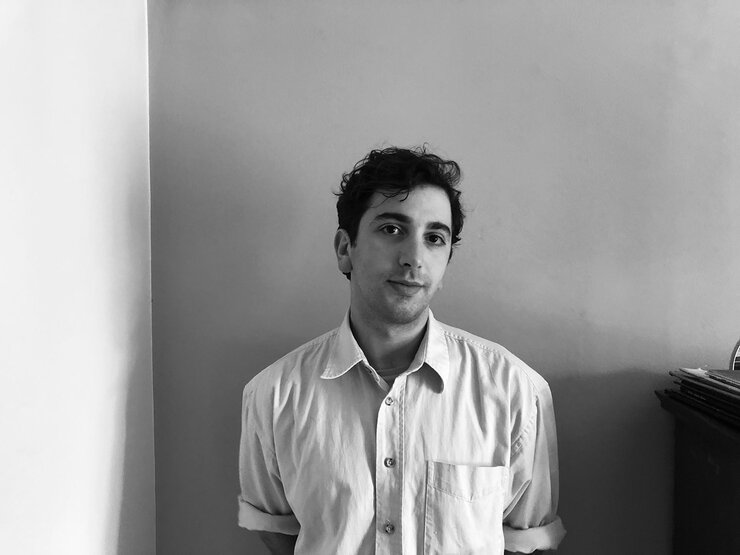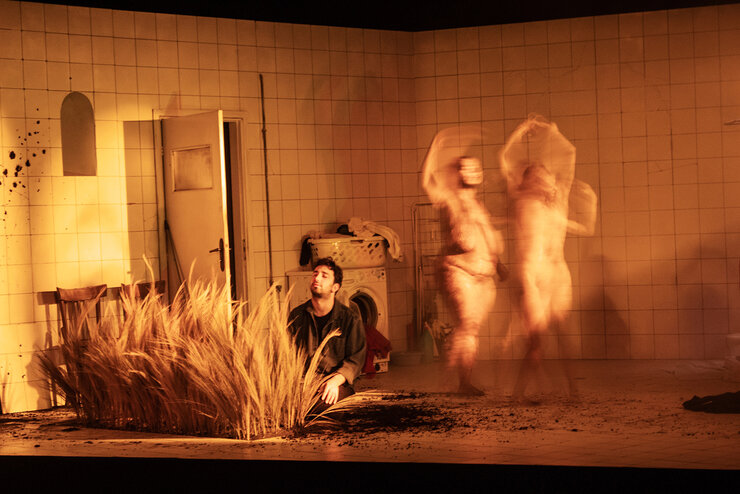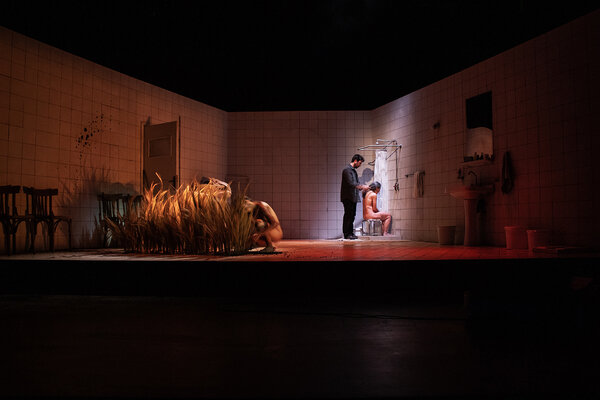
«I believe some moments are so important, they are beyond words.»
Mario Banushi is one of the most important new voices in European theatre. Born in 1998, he lived in Albania until the age of six before moving to Greece permanently. He studied acting at the conservatory in Athens. During his studies, he was a production assistant for Euripides Ladkaridis' performance «THIRÍO» (Athens Biennale 2018). After graduating in 2020, he directed the short film «PRANVERA» (TIFF 2021) and appeared as an actor in the performances «Marcel Duchamp» (2022) by Nova Melancholia and «City Lights» (2022) directed by Amalia Bennett. An excerpt of his production «Ragada» was presented during Performance Rooms 2022 (Kappatos Gallery). The complete version then premiered at Theatro sti Sala (Theatre in the Living Room). His next work «Goodbye Lindita» was performed at the experimental stage of the National Theatre of Athens. «Taverna Miresia» Mario Bella Anastasia», the last part of the trilogy, was shown at the Athens Epidaurus Festival in July 2023 and is now celebrating its Swiss premiere at the Zürcher Theater Spektakel. The interview with Mario Banushi was conducted by curator Lea Loeb.

Mario, we are very excited that you are coming to Zurich. «Taverna Miresia – Mario, Bella, Anastasia» is the third part of a trilogy, and it premiered exactly one year ago at the Athens Epidaurus Festival. You started the trilogy in 2022 with «Ragada». The second piece was called «Goodbye Lindita». All three parts deal with family, love, and grief. How does grief relate to theatre? How do you deal with grief in your work?
I learned a lot about grief with my piece «Goodbye Lindita» as it involves a lot of my personal life, my family, my memories. For me this piece is like a funeral, honouring the memory of my stepmother. I remember how the congratulation by the audience after the piece felt strange to me, almost like a eulogy at a funeral. I remember struggling a lot with those feelings at first. I would go home with a very heavy feeling and cry a lot for the first weeks after the premiere. This is when I understood that this is the risk of sharing my most intimate feelings in my work.
But I also understood that sharing all of this can be beautiful. Artistically and personally, I like to take risks and to step out of my comfort zone. So even though it was a very heavy and intense period for me, I realised, that this is what I want to do. I want my work to be personal and I don’t want to ever change this, even if it makes me vulnerable sometimes. In Greece, we use a phrase: «Don't hide the things under the carpet.» Because, of course, they disappear but will eventually come back to light at some point.
By sharing my feelings and my grief with the audience in theatre, I found a way to avoid hiding. It has happened many times that the audience would approach me after a show to share their stories with me. Something about my work seems to touch people and to make them want to share their feelings with others. This is beautiful to see, and it makes me proud. For me, theatre is as a space where we can grieve together, where we can share feelings, not just images and words.
In your three pieces, certain elements recur; for example, there are no clear characters or a continuous narrative. I would describe your work as visual theatre, an atmospheric experience, a tableau. Can you relate to that?
Yes, I do. Although, in fact I never know how to name what I do neither (laughs). Sometimes I call it theatre, sometimes physical theatre, and sometimes dance, because I work with dancers, and we use a lot of dance and body language. I just try what naturally comes to me as an artist and I don’t want to limit my practice. I like being a director, but I also love doing ceramics and working with my hands. I also draw a lot. I enjoy the combination of different artistic expressions.

The trilogy manages entirely without language. Theatre without text is something we rarely see. Can you tell me more about what spoken language means to you, and why you don't use it in your pieces?
I believe words are very important, especially those we share with loved ones or during significant moments in our lives. It's not that I think words are unnecessary. Of course, they are important. However, in my life, my country, and my community, I feel we talk a lot but don't give enough space to feelings. We don't give room for physical communication. Especially after COVID, we have lost this sense of connection. There are many reasons I don't use text in my work. One reason is that my experience of grief within my family was lived without words. We expressed it through crying, touching, hugging, eating, and mourning by just being together. We didn't really talk.
I believe some moments are so important, they are beyond words. In the most crucial moments in life, saying something often feels too simple. I'd rather look someone in the eyes and remain silent. Even in my personal life, despite giving interviews and participating in Q&A sessions, I prefer not to talk too much. I prefer to let the moment speak for itself rather than relying on the words we're taught to use by schools, parents, and universities. I resist putting myself in a box, even when I speak. I try to express myself genuinely, as Mario, not as others expect me to be. These are some of the reasons I don't use text in my performances. It's not a clear-cut decision but something that evolved naturally. From a young age, I loved drawing, and I loved images in general. I remember looking through family photo albums, cherishing those visual memories. My mother's and grandmother's dresses in those photos still stand out to me. I could look at those albums for hours and become completely absorbed in those images, those captured moments in time. I cherish what can be seen and smelled more than what can be explained through words.
When we first met and talked about your piece – I had only seen a recording – you told me that the video would not represent your work at all. That I would need to feel and smell it to understand.
Yes, I use a lot of sensory elements, particularly the sense of smell. It's very important to experience my work with all the senses. Throughout the trilogy, I use a particular scent. It is the smell of incense, which is often used in churches in Greece and various parts of the Balkans. It evokes the atmosphere of churches and religion, topics that are of course very present in my pieces. I also associate the smell with a family tradition of burning this incense at home for good luck on Sundays. This scent resonates not only with people from the Balkans. Working with the sense of smell enables a particular connection with the audience.
I am working on my new piece now and I am asking myself what scent to use and how to incorporate it. I enjoy creating moments where, even if the lights are off and you can't see the piece, it's still present through smell. For example, when working with ceramics on stage, the audience can smell the combination of dust and water, that creates this earthy smell that I love so much. What you can perceive in the dark, through hearing or smelling, is just as important to me.

Another recurring element in your pieces, is nudity. We see naked bodies of all ages, often women, and there are often scenes where bodies are being washed on stage. Can you tell me more about it?
Nudity isn't a premeditated decision; it comes naturally. Of course, my team and I discuss and decide on it together. It's crucial for me to create a space where everyone feels comfortable and not to include nudity just for the sake of it. I don't use it exploitatively, which is why I think it doesn't shock the audience, when they see a body undressing on stage. As a child, I often drew women because I was raised by women — my grandmother, stepmother, mother, and my sisters. The men in my family weren't as present. Until this day I feel more comfortable and familiar being surrounded by women. That's one reason why I often work with female performers. And also with female nudity. Nudity, like the sense of smell in my work, connects us to something more primal and earthy, reminding us of how we came into this world. My work aims to strip away societal layers and return to the basics: earth, nudity, birth, smell, touch, and hug—those fundamental experiences from our lives.
And what about the washing of bodies? It occurs in all three pieces.
The washing of the bodies wasn’t a predetermined element for the trilogy. However, when I noticed that this motif of washing a body kept recurring, I began to appreciate its significance and the unique yet similar messages it conveyed across the different pieces. In «Ragada», this image is particularly important. The performer washing and lathering a woman's body connects this with her own deeply personal memory. We talked for hours and days about her feeling of regret and disconnection from her origins. She felt lost and detached from her roots. This topic appears in «Taverna Miresia» as well, where a woman is being baptised. I guess it reflects my own experience as an Albanian getting baptised in Greece, where our names were changed. I remember it felt like I was renouncing and forgetting my origin, my earth, and my family. In «Taverna Miresia», the woman being baptised has dust on her body, representing her homeland. The act of washing off the dust symbolises removing her connection to her country. The washing scene in «Taverna Miresia» is like baptising myself again, preparing and cleansing myself in front of the audience. This ritualistic act of washing my body and mind to demonstrate my willingness to engage with the audience. I carry many memories connected to this ritual of washing. For me, this act of washing our bodies on stage serves as a warm-up, comparable to the exercise some performers do before going on stage. We do backstage warm-ups as well, but this warm-up happens in front of the audience and is integral to the performance. We prepare together for this new encounter.

Another very interesting aspect of your work, which seems to be a central element, is the interweaving of the domestic and the supernatural. Can you elaborate on this?
For me, it's like a game or a trick. When introducing something to someone, it's easier to start with something familiar. I like to begin with everyday objects that everybody recognises. From there, I gradually introduce elements that are less familiar and more magical. I wouldn't start a piece with a surreal image or nudity right away because it might alienate the audience. Instead, I want to ease them into my universe. By starting with familiar settings — like a washing machine, a table and chairs, or a bed — the audience feels comfortable. Gradually, I introduce the magic, transforming the world they know into something else. This approach prevents discomfort and allows the audience to open up, much like children do when they encounter new and wondrous things.
In other words, you want to draw attention to the magic in our daily lives.
Exactly. I believe in the energy of objects and their histories. I love the objects in my house and enjoy remembering their stories. Objects have had lives before us, and I cherish that connection to another time. This interest in objects and their own lives, extends to my work. For example, the movement of a curtain, that is moved by the wind, feels magical and symbolic to me. The air moving the curtains symbolises the invisible forces affecting our lives. In my performances, objects play a significant role alongside the performers, creating a dialogue between the tangible and the surreal.
How does it feel for you, to be performing in your own pieces?
It's strange because I never feel like performing in the sense of playing a role. I really feel like myself, like Mario. I'm watching my family, my memories, and the things I've seen in my life on stage. This started with «Ragada», the first piece I created, which was very homemade. I didn't have the budget to hire someone to handle the music or lights, so I did everything myself — performing, playing music from my phone, controlling the lights. It was like a one-man-show. So, I decided to perform in the whole trilogy as myself. I enjoy being on stage, observing my family and recreating memories. This is how I approached the trilogy, as Mario — as director and artist, deeply involved in my memories, that are as well my work.
Is there anything you want to share with the audience in Zurich?
I feel honoured to be the first Albanian artist presented in the main programme of the festival. It's a significant milestone for me and an important step for Albanian society and immigrants in Switzerland, I believe. I'm grateful for this opportunity and excited to visit Zurich and Switzerland for the first time ever. I have relatives in Switzerland whom I've only talked to on the phone, and now I'll get to meet them in person. So, this trip is not just work for me; it's a chance to share my work and reconnect with my family. I am looking forward to a very special experience.
Credits
Interview: Lea Loeb
Photos: Afroditi Kapokaki, Nassia Stouraiti and Theofilis Tsimas